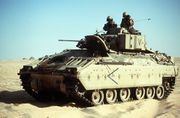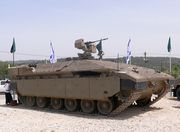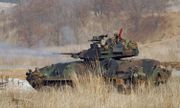Infantry fighting vehicle


An infantry fighting vehicle (IFV, also known as (mechanized) infantry combat vehicle, (M)ICV) is a type of armoured fighting vehicle (AFV) used to carry infantry into battle and provide fire support for them.
Contents |
Background
IFVs are similar to armoured personnel carriers (APCs), designed to transport five to ten infantrymen and their equipment. They are differentiated from APCs ("battle taxis") by their enhanced armament (allowing them to give direct-fire support during an assault), firing ports (allowing the infantry to fire personal weapons while mounted), and usually improved armour.
They are typically armed with an autocannon of 20 to 40mm caliber, 7.62mm machine guns and possibly with anti-tank guided missiles (ATGMs) and/or surface-to-air missiles. IFVs are usually tracked, but some wheeled vehicles fall into this category, too. IFVs are generally much less heavily armed and armoured than main battle tanks (MBTs), but they sometimes carry missiles, such as the NATO TOW missile and Soviet Bastion which offer a significant threat to tanks.
Arguably, the first mass produced IFV was the West German Schützenpanzer 12-3 which served in the Bundeswehr from 1958 until the early 1980s. The SPz 12-3 mounted a 20 mm autocannon in a small turret and carried a half-squad of five armored infantrymen.
Western powers were surprised when the Soviet Union paraded the first purpose-designed IFV, the BMP-1, in 1967. The BMP possessed a very low profile and was armed with both a 73mm smoothbore gun and an AT-3 Sagger ATGM. Its steeply-sloped front armour offered full protection against NATO's standard .50 calibre machine gun and partial protection against 20 millimetre Oerlikon cannon both in a 60 degree frontal arc, while its 73 mm gun and ATGM were a threat to NATO APCs and even MBTs.
Since then, all major military powers have developed or adopted IFVs. Examples include the German Marder and Puma, the Chinese ZBD-97, the Soviet/Russian BMP-3, the Indian Abhay IFV, the Canadian LAV III, the British Warrior, the American M2 Bradley, the Spanish Pizarro/ASCOD, the Italian Dardo, the South African Ratel, the French AMX-10P, the Swedish Combat Vehicle 90 and the Dutch YPR-765 AIFV.
 Czech/Russian BVP-2 |
 Swedish CV90 |
Canadian LAV III |
US Marines LAV-25 |
 Israeli Namer |
 German Puma |
French VBCI |
Pindad Panser Indonesia - ANOA 6X6 APS UN |
|
APC Indonesia Pindad Panser - ANOA 6X6 APS |
 British Warrior IFV |
Spanish-Austrian ASCOD AFV |
Australian ASLAV |
Heavy infantry fighting vehicles
To cope with urban combat and mine warfare, including the use of large improvised explosive devices, there have been a number of heavy IFVs (HIFV) with the high protection level of a tank developed, based largely on experience of the Israel Defense Force (although the Canadian Kangaroo of World War II could be called the first). The Israeli Merkava tank is capable of carrying a few infantrymen or extra ammunition in the back;[1] the Achzarit is a T-55 tank modified to be heavily armored personnel carrier; and the Namer is a redesigned Merkava tank without a tank gun.
Another example is the Russian BTR-T, also based on the T-55. BTR-90 is another promising project of Russia. The Ukrainian BMT-72 and BTMP-84 are based on lengthened T-72 and T-84 main battle tanks, respectively, and retain the tanks' 125mm main guns.
Doctrine
In times of asymmetrical warfare, local crises, and urban combat zones, the IFV is more important than ever. The IFV offers a viable compromise between mobility, protection, and firepower. They can be used in high and low intensity conflicts as well as peacekeeping operations. The latest vehicles, like the Patria AMV, have been designed with an emphasis on modularity that improves their ability to be repaired in the field.
Most IFVs are amphibious and air transportable. Wheeled IFVs can travel great distances on their own without needing to be transported by flat-bed trucks and railway, as required by tracked IFVs. Tracked IFVs need to have their treads serviced or replaced on a regular basis. The tracks themselves and the weight of the IFVs tend to be tough on road surfaces, wearing them down more quickly than a wheeled IFV. Consequently, wheeled IFVs have greater mobility.
Moreover, many wheeled IFVs can extract themselves from a battlefield even on flat tires, while an IFV with damaged tracks would require a heavy vehicle to tow it out. However, tracks cannot be punctured like a tire, offering greater off-road mobility and greater maneuverability than wheels.
Design
Armour and countermeasures

Generally, IFVs have thinner and less complex armour than tanks to ensure mobility. Most IFVs are invulnerable against heavy machine guns, artillery fragments, and small arms. The IFV's mission does not include anti-tank duties except in emergencies or in support of tank units; therefore, it needs less protection from heavy weapons fire. Instead, the IFV, as its name implies, is supposed to carry riflemen and their weapons into the battlefield where they dismount and fight outside the vehicle with the support of the IFV's main armament.
In IFVs, the thickness of armour varies widely between models. Some vehicles are proofed against nothing larger than 12.7 mm projectiles while others, such as Sweden's CV90, US Bradley M2A3 and German's Marder 1A3, can withstand frontal hits from 30 mm autocannon. The sides, roof, and floors of IFVs have thinner armour. Vehicles must also protect crew against anti-personnel mines and against anti-tank mines.
Newer vehicles like the Finnish Patria AMV use armour made in interchangeable modules of various thickness. This permits the vehicle to be tailored for particular missions such as decreasing the weight of vehicle for air transportation or strengthening the protection if it engages in dangerous missions. The latest models of the Russian BMP-3 use the Arena active protection system (APS) that protects the vehicle from guided and unguided missiles with velocities from 70 to 700 metres per second. Israeli IFVs will soon employ the "Iron Fist" APS which can defeat kinetic APFSDS tank rounds.
The most common counter measures are smoke grenade dischargers. These help IFVs to avoid a hits from ATGMs by allowing the IFV to hide behind a smoke screen. Some vehicles, such as the French VBCI, employ infra-red jamming flare dispensers. These are effective against missiles with IR guidance systems.
Armament

The primary weapon on most IFVs is an autocannon, usually of a calibre between 20–40 mm, although IFVs such as the BMP-3 carries a 100 mm gun/launcher. It is effective against a wide range of targets such as unarmoured and lightly armoured vehicles, infantry, helicopters and low-flying aircraft. It can fire several types of munitions, including high explosive, incendiary, and kinetic penetrator rounds. Germany's Puma and Sweden's CV90 can fire air burst munition, that contain hundreds of tungsten rods that are effective against vehicles, helicopters, and stationary strong points. IFV cannons can elevate their barrels by as much as 70 degrees to permit their crews to engage aircraft.
On many IFVs, a coaxial machine gun is mounted on the turret along with the main armament. The most common calibre is 7.62 mm & .30 cal. Some vehicles mount more machine guns; for example on the German Marder, one machine gun fires from the rear of the vehicle.
Some IFVs are equipped with anti-tank guided missiles. These missiles are mostly medium range (2000–4000 m). Others carry surface-to-air missiles or a combination of the two, such as the 2T Stalker.
Some new vehicles, such as the Puma, come equipped with 30, 40, 76, or 81 mm grenade launchers. Most IFVs also have smoke grenade dischargers for concealment.
See also
- Armoured warfare
- Armoured personnel carrier
- List of AFVs
- List of modern armoured fighting vehicles
- BMP Development
- Mechanized infantry
Notes
- ↑ The Encyclopedia of Tanks and Armored fighting vehicles: From World War I to The Present Day. Grange Books, 2006. p.222
|
||||||||||||||